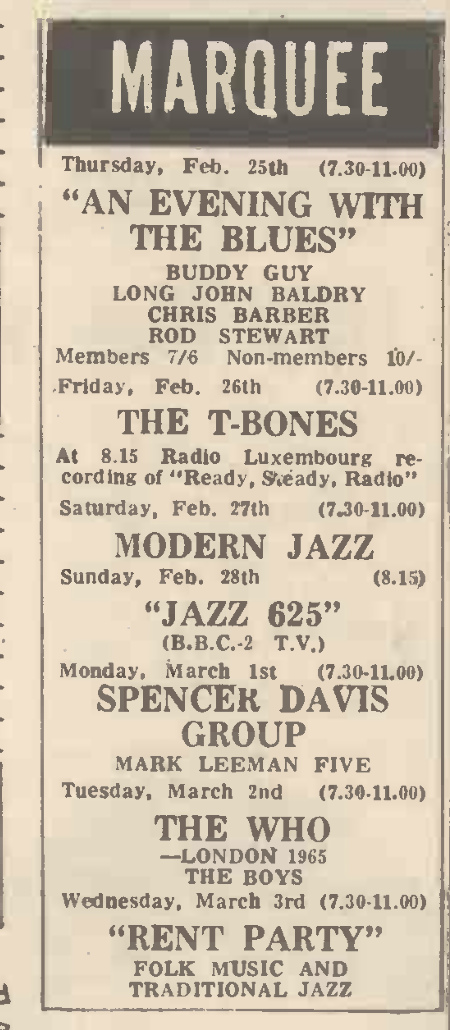The Who London 1965 . . . Ealing Club, Feburary 1965 with Fery Agasi (pinched from HERE)
The Who – Maximum R&B Tuesday Nights at the Marquee . . . a 23 week residency that became a cornerstone of the band’s foundation myth. As much as anything we have the classic poster to thank for that impression, reinforced by the one in The Who Live at Leeds package. Yet, the majority of the residency at the Wardour Street club appears to have been advertised not in its maximalist rhythmic and bluesy incarnation but as ‘THE WHO – LONDON 1965’. Sometimes with the hyphen, sometimes not . . .
An original is on the left, above is the Live at Leeds repro
‘Maximum R&B’ was used from November through to December 1964. The Monday Red Lion and Wednesday Florida gigs were in the same week the block ad, below, appeared in Melody Maker
Following the Kit Lambert and Chris Stamp takeover there was obviously an on-going debate over the band’s name or rather how best to present it. The first show of the residency, November 24, they were billed a ‘THE “WHO”’ which seems to have been the case until January 5 when the quotation marks were dropped, though they were back on the 12th and stayed in place until the first gig in February, when they went absent once more. From February 9 until April 6, if you paid to see The Who at the Marquee it was under the banner ‘THE WHO – LONDON 1965’. For the final couple of Tuesday gigs in April, the 27th being the last of the 23, they were simply ‘THE WHO’.
On the Brunswick label for ‘I Can’t Explain’, and in press advertisements and posters promoting the single, there was never any uncertainty over the name, they were just ‘The Who’. The heavily used appendage ‘LONDON 1965’ for the Marquee (and Ealing Club dates in February) was then a statement and a declaration. It was a contract with their audience that laid down the claim that they were not only at the very centre of things in Soho, but they were its centre – ‘right here, right now, we are what’s happening’, it said.
Melody Maker (March 20, 1965)
An April ‘65 interview with Kevin Swift, published in the May edition of Beat Instrumental, doesn’t refer to any of this directly, but it is there in plain sight – Stamp and Lambert ‘look upon them as the embodiment of London’s various characteristics’, Swift wrote:
It is quite a valid theory when you consider if for a moment. After all, their act contains an aggressiveness, humour, action and an overall indication of frustration.
London – The Who. The Who – London. Even the name is representative of the anonymity of the big city
Beat Instrumental (May 1965)
THE WHO – PRIMITIVE LONDON 1965
Record Mirror (December 19, 1964)
The High Numbers Record Mirror (July 23, 1964)
August 8, 1964
New Musical Express (April 23, 1965)
Before the Pop Art epiphony of ‘Anyway Anyhow Anywhere’, Townshend was already dumping the Mod tag: ‘this was a contrived artificial modness and we wanted to be ourselves’. Lambert’s reference to the band appearing in four films is intriguing. The French TV programme had been trailed in Britain as early as March in Record Mirror, with filming taking place at the Marquee, in Shepherd’s Bush and Hammersmith, Mods – Seize Millions de Jeunes (Sixteen Million Teenagers – tx March 18, you can find it on Vimeo as originally broadcast). Lambert is the ‘adult’ interlocutor, explaining teenage London. In one shot you see Moon (?) seemingly helping to design the Marquee poster but,The Who’s appearance aside, the highlight is the kids, smashed blocked and dancing like beautiful fools to some other band chopping away on Bo Diddley’s ‘Who Do You Love’.
One of the two British TV spots could be Ready Steady Go (tx January 29) and the promotional short for ‘I Can’t Explain’ shot by the two managers and sold to Rediffusion to be used in ‘That’s For Me’ (tx March 15). The film ‘about a stripper’ was Carousella. The reference to it in this NME piece confirming, for me at least, that the band and management had contracted/cleared their appearance with the documentary’s producers, Mithras Films. They were billed as “The Who”. . . Much, if not all, of this on the films is in Andy Neill and Matt Kent’s essential Anyway Anyhow Anywhere: The Complete Chronicle of The Who (2007)
Screengrab from Carousella
Mail Bag, Melody Maker (June 19, 1965)




















































